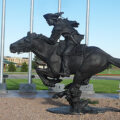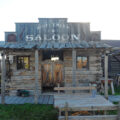By Renée S. Gordon
“Although my skin is of a different hue, yet I am a man. God made me.”
–Ponca Chief Standing Bear 1879
The 1862 Homestead Act gave settlers the right to claim 160-acres of land at no cost to settlers, regardless of race or sex, who paid a filing fee and lived on the land and improved it for a period of five years. Alternatively they could purchase the land for $1.25 per acre after living on it for 6-months. Under this act 270-million acres were claimed, 10 percent of the US, and thousands of lives were affected. Many ethnic groups, including African Americans, took advantage of the act. It should be noted that initially Native Americans could not take advantage of the act. www.nps.gov/home
The Homestead Heritage Center opened in 2007 to be a monument to those intrepid settlers and interpret the complete story of homesteading. The center points west and looming above the prairie the roofline is designed to resemble a single-bottom plow breaking through sod.
On the building façade individual posters depict famous people who benefitted from homesteading, Whoopi Goldberg, Jewel, George Washington Carver, etc. The complex is comprised of a museum, 1872 Freeman School, Palmer-Epert cabin and 2 miles of trails. The Cultural Resource Staff provides a list of services including a digital oral history collection, photographs, document analysis and monument tours. www.visitbeatrice.com
Rock Creek Station State Historical Park is a must see site for a “true” understanding of the daily routine of those determined to travel west as well as ways in which events are transformed into legends. They are all here, the settlers, traders, trappers, Buffalo Bill and the Pony Express waiting to tell their stories. The 360-acre park has preserved the area, creek bottoms, hilltops, indigenous plants, ravines and deep swales or ruts carved into the terrain by an endless flow of wagons, in pristine condition. Mark Twain visited and wrote about this station in “Roughing It,” the story of his journey west following the Pony Express Trail beginning in 1859.
In 1857 S. Glenn established the station on what was the interstate of the era at one of the toughest trail crossings. Rock Creek was two weeks from St. Louis and it is estimated that 300,000 people crossed through this point. The site today encompasses three graves, one a nameless schoolteacher, West Ranch Cabin, Tollhouse and Bridge, Bunk House, East ranch House and Pony Express Barn. Tours are self-guided and begin in the Visitor Center with an orientation film and displays of artifacts and photographs. The route parallels the trail used in the 1800s.
The West Cabin was a “road ranch,” a privately owned establishment offering travelers goods and services. A common complaint was price gouging. Crossing the station’s toll bridge you will see the tollhouse where travelers paid to cross. The bunkhouse was used for those traveling by stage as a dining room and rest stop. The Pony Express Barn is a reconstruction based on an 1860 photograph. The interior is exactly as it would have been when the Pony Express riders (April 1860- October 1861) stopped here.
The next stop is the infamous East Ranch Cabin. On July 12, 1861 the cabin, then the station headquarters, was the scene of James Butler “Wild Bill” Hickok’s shooting of David McCanles who had come to the station to obtain payment from a land sale. McCanles died instantly and two other men died later of their wounds. The East Ranch Cabin is set up to replicate from descriptions its appearance on that day in 1861. Some deemed it a murder and others an act of heroism. Hickok pled self-defense in court and was acquitted.
In 1866 the station was sold to Wells Fargo Stage Line and shortly thereafter the transcontinental railroad sounded the death knell for that form of travel. www.outdoornebraska.org
Lincoln, Nebraska was founded in 1856 in proximity to a salt basin and in 1859 it was named Lancaster and became the county seat. Salt mining in the area was never very lucrative and when mines were acquired in Kansas they became obsolete. In 1867, Lancaster was selected over Omaha the territorial capitol, as the state capitol based on location. It was renamed in honor of Abraham Lincoln and the city was laid out. Planners included sites for government offices and institutions to insure the city’s economic base. www.lincoln.org
The Nebraska History Museum is the only museum to tell the entire state’s story and holds the largest collection of Nebraska artifacts. A tour of the three story institution begins with a state map that serves as orientation to its geographical history and natural resources. Nebraska has more miles of river than any other state with its main river being the Platte. The Great Platte River Road was the juncture of the major trails west. Continue to the five exhibits currently on view, “First Nebraskans”, “Nebraska Joins the Union”, “Building the State”, “Nebraska and World War II”, “Nebraska Cowboys: Lives Legends & Legacies.”
The WWII exhibit is well done with dioramas, artifacts and memorabilia. It opens in a living room where a radio announcer tells of the bombing of Pearl Harbor. More than 80 percent of the bombs used were made in Nebraska, as was the Enola Gay aircraft.
Nebraska Cowboys, a special exhibit closing in January 2015, takes you inside the realities of being a cowboy. Dioramas and interpretive panels, paired with artifacts and photographs, bring cattle drives to life. Each cowboy owned his own saddle but the ranch owner supplied the 6-10 horses he needed for the drive. Information is given on the diverse ethnicity and history of the profession. www.nebraskahistory.org
University of Nebraska’s current Sheldon Art Museum dates from Mary F. Sheldon’s gift of money to build an art museum. Philip Johnson designed the structure, dedicated in 1963. The 12,000 permanent holdings are compilation of two others, the 1888 Sheldon Art Association and the 1929 University of Nebraska collection and newly purchased works. The works are transnational, are presented thematically and rotated annually. It is historic American art with a traditional and modern focus.
Highlights of the collection are the Pop-Art Collection and works by Edward Hopper, H. Lee Smith, Benjamin West, Jackson Pollack, Alfred Stieglitz and Robert Scott Duncanson (1821-72) the first African American to receive international acclaim. Duncanson supported abolitionism with his art and recent research has theorized that there are symbolic references to the UGRR in some of his landscapes, notably the one in the Sheldon.
In 1970, the Sheldon Sculpture Garden was dedicated. It began as 2.5-acres immediately outside the museum. There are now 30 sculptures throughout the campus. www.sheldon.unl.edu
Four capitols, two territorial in Omaha and two state in Lincoln, preceded the current Nebraska State Capitol. Architect Bertram Grosvenor Goodhue won a competition and in 1922 ground was broken. The building was completed in 1932 at a cost of $9,800,449. It is the most architecturally symbolic of the state capitols and honors Native American, European heritage and the 93 counties.
Four wings fan out from a 400-ft. tower with a central dome topped by a 19-ft. sculpture of “The Sower.” The low horizontal wings represent the flatness of the prairie and the vertical tower characterizes the hopes and dreams of the settlers that rose from the land. The huge staircase that leads to the entrance embodies the hardships the people overcame. The doors are crafted using Native American designs. Twelve and a half foot Shocks of wheat and corn support the 15,000-lb. “Sower” as he hand sows the seeds of life. Thematic inscriptions around the exterior include Indian prayers and quotes. Daniel Chester French created the bronze sculpture of Lincoln on the West Plaza.
Free tours are offered of the interior. The columns on the main floor weigh 15-tons each and are solid marble. The ceramic ceiling tiles are 20K gold glazed and 20 murals tell the story of Nebraska. Do not miss the beautifully appointed, acoustically perfect, Supreme Court Room. Nebraska is the sole state with a nonpartisan, unicameral legislature.
Murals placed around the dome are visible in the 14th floor Memorial Chamber. “The Trial of Standing Bear” is extremely moving. On this floor you can access the observation deck. The “Tower of the Plains” and grounds have been a registered National Historic Landmark since 1997
Lincoln’s eight block Haymarket District dates from the time the city was called Lancaster. The original homes and stores were replaced in the 1880s by warehouses and businesses. Modern Haymarket is Lincoln’s most vibrant arts, entertainment, shopping and dining district having undergone a $60-million redevelopment. www.lincolnhaymarket.org
Lazlo’s Brewery and Grill, an oft-awarded brewery, is in the Haymarket and it is a must stop for the brews and the food. www.lazlosbreweryandgrill.com
A city this historic is bound to have iconic accommodations. The Cornhusker, a Marriott Hotel, is situated in the center of all the best Lincoln has to offer, most within walking distance and connected to downtown via skywalk. The hotel has all the luxury amenities and heated pool, concierge level, gym, multiple dining options and offers special rates and packages. http://www.marriott.com
Think outside the East Coast box and add a trip to Nebraska to your vacation list. You won’t believe what a great time you will have. Read more about the state and access planning tools at www.visitnebraska.gov
I wish you smooth travels!
TRAVEL TIPS:
Dedication Day, November 19, 2013, is the 150th anniversary of Lincoln’s Gettysburg Address. The occasion will be honored with special events, a parade and thousands of Civil War re-enactors during Remembrance Day Weekend, November 22-24, in Gettysburg, PA. Make plans to attend. www.gettysburgcivilwar150.com
“The Surrealists: Works from the Collection” will be on exhibit in the Perelmen Building of the Philadelphia Museum of Art from November 3, 2013- March 2, 2014. More than 100 artworks and documents created by more than 50 artists will explore and interpret the Surrealist Movement that began in the Paris of the mid-1920s and migrated to the U.S. during WWII. Artists including Chimes, Miro, Giacomtti, Dali and Man Ray are represented by works culled from the museum’s permanent collection. The exhibition is presented thematically and chronologically and is augmented with special programming and events. www.philamuseum.org
















Leave a Comment